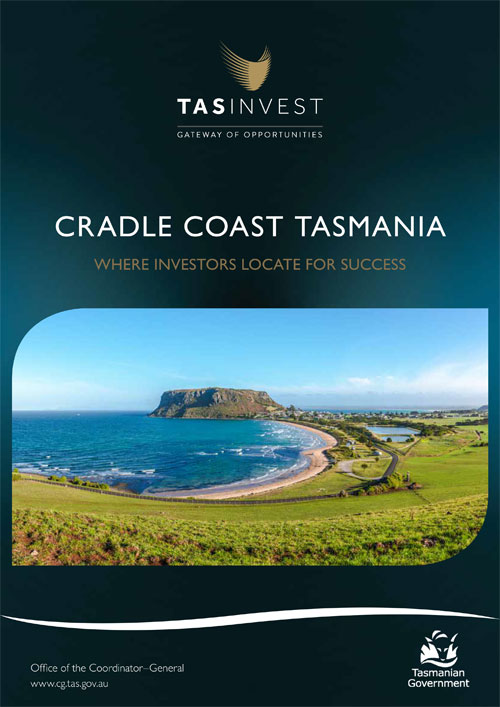INDUSTRY &
INVESTMENT
CRADLE COAST INVESTMENT PROSPECTUS
Welcome to the Cradle Coast where investors locate for success and individuals locate for productivity and lifestyle.
Drawing upon unique investment and lifestyle advantages, Tasmania’s Cradle Coast offers the perfect ecosystem in which to locate operations in well-established sectors of advanced manufacturing, agribusiness and tourism. It also is an ideal location for emerging sectors in renewable energy, shared service centres, data centres and agri-tourism.
Home to over 7 800 businesses, the Cradle Coast delivers $6 billion in Gross Regional Product. With its lifestyle offering, it is the place to live and work. With continued strong competition for the best talent, the Cradle Coast is an ideal place to offer the flexibility of working remotely and for you and your business to relocate.
STARTING OR MOVING A BUSINESS TO THE CRADLE COAST
The Cradle Coast region presents significant opportunities across a diverse range of industries from advanced manufacturing, agriculture, forestry, mining, retail and tourism to the rapidly expanding renewable energy and agri-tourism sectors.
Commerce and industry in the region is supported by outstanding infrastructure including a network of highways and roads, a number of ports, including Tasmania’s largest port at Burnie, and two regional airports serviced by major and regional commercial airlines.
All of this, less than one hour’s flight to Melbourne, makes this region a logical choice to establish or expand your business.


OPPORTUNITIES TO INVEST
There’s many reasons to invest in businesses, land and development on the Cradle Coast. From affordability, ease of trade, proximity to mainland Australia and opportunities for growth and expansion, it really is a unique and rewarding area to invest in. Various investment opportunities exist on the Cradle Coast ranging from commercial land, investment properties to small businesses.
RESIDENTIAL PROPERTY
The Cradle Coast Region’s building approvals are used as a leading indicator of the general level of residential development, economic activity, employment and investment. Residential building activity depends on many factors that vary with the state of the economy including interest rates, availability of mortgage funds, government spending, and business investment. At June 2017, Cradle Coast Region had a median house valuation of $252,426, $61,588 lower than the median house valuation for Tasmania.
COMMERCIAL PROPERTY
Rural land is used largely for agriculture (particularly dairy and beef farming and vegetable and crop growing, with some poppy and pyrethrum growing), and timber production. Mining and tourism are also important industries. The Cradle Coast Region encompasses a total land area of nearly 23,000 square kilometres. The LGA with the largest population in the Region is Devonport City, with the King Island Council area having the smallest population.
ADVANCED MANUFACTURING
The Cradle Coast offers the combined benefits of low manufacturing costs, skilled labour and competitive wages with a strong industrial base. The largest manufacturing sectors in the region are food and beverage, wood products, textiles, metal products, machinery and equipment. Established supply chain links across the mining, agriculture, and forestry sectors provide strong support for further development of value-added manufacturing in the future. Competitive advantages includes easy access to road, rail, air and sea freight, a skilled workforce and competitive cost base.
PRIMARY PRODUCTION
The Cradle Coast region has a thriving agricultural industry with some of the best farming conditions in Australia. A mild temperate climate, coupled with productive soils and access to abundant fresh water supplies creates the ideal environment for cropping, dairy, livestock, and many other niche agricultural products. A state-wide irrigation scheme introduces further possibilities for agricultural land use and ensures existing farms have a plentiful supply of water in the dryer months. As an island surrounded by pristine waters, Tasmania also offers prime positioning for the aquaculture industry.
TOURISM
Home to some of Tasmania’s and the world’s iconic natural locations such as Cradle Mountain, the Franklin River, and ‘The Nut’ at Stanley, the Cradle Coast Region is experiencing year-on-year growth in tourist numbers as local and overseas visitors flock to the region. Tourism has benefited from significant investment in recent years. Stylish accommodation, contemporary cafes and restaurants, and new activities are making the region more appealing than ever.
RESOURCES & MINING
The Cradle Coast region has great geological diversity with the Mt Read Volcanic Belt one of the richest mineral provinces of its type in the world. The region is a host to a number of major mines, with a small number of large-scale metallic mining operations providing a majority of Tasmania’s total unprocessed mining product. The processed metals and metal products sector is Tasmania’s largest exporter, accounting for more than 40 per cent of products sent to overseas markets. Exported commodities include ores, concentrates, and processed metals of aluminium, cadmium, copper, iron, lead, tin and zinc.
RENEWABLE ENERGY
Tasmania has been a forerunner in the development of renewable energy generation with more than 100 years of continued investment in renewable energy infrastructure and technology. As a result, Tasmania has an unmatched level of skill and experience among our renewable energy engineers and technicians. Tasmania is in the enviable position of having a supply of renewable energy that meets a significant proportion of the State’s energy demands as well as providing a profitable surplus for interstate export. This renewable energy is predominantly from Tasmania’s extensive hydro generation and storage schemes, but also with significant contributions from Tasmanian wind farms.

